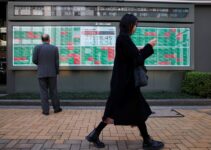The rally in tech megacaps gained further traction, with the Nasdaq 100 notching its best ever first-half of a year and Apple hitting the $3 trillion milestone.
Traders looked at the glass half full after data signaled inflation is moderating at the expense of economic growth. Equities extended this year’s surge, with tech consolidating its leadership amid the ascent of artificial intelligence. Big banks saw their first monthly gain since January after passing the Federal Reserve’s stress test. After the close, JPMorgan Chase & Co., Wells Fargo & Co., Morgan Stanley and Goldman Sachs Group Inc. announced higher dividends.
Nearly $5 trillion has been added to the value of companies in the Nasdaq 100 since the start of the year, with the tech-heavy gauge defying bubble warnings and jumping almost 40%. The advance in the most-influential group in the S&P 500 helped push the index up 16% in 2023. Gains have been even more pronounced when narrowed down to the megacap space — which has soared 74%.
“I still do like big tech,” Larry Adam, chief investment officer at Raymond James, told Bloomberg Television. “I do believe in technology continuing to reinvent itself — obviously with the latest addition being AI. That’ll continue to drive earnings.”
The “Big Seven” — including Apple, Microsoft Corp., Alphabet Inc., Amazon.com Inc., Meta Platforms Inc., Nvidia Corp. and Tesla Inc. — boosted profits by 14% a year during the decade through 2022. While their combined earnings slumped more than 20% last year, they’re expected to recover swiftly.
The Nasdaq 100 rose over 1.5% Friday, while the S&P 500 hit the highest since April 2022. The US equity benchmark posted its best first half since 2019. Nvidia, which has almost tripled this year, was up about 3.5%.
If history is any guide, the Nasdaq 100’s strength this year augurs well for the rest of 2023.
Years that start with rallies in the index of at least 10% average returns of about 14% over the second half of the year, though that shrinks to an 8.3% gain when the first-half gain tops 20%, according to an analysis of data compiled by Bloomberg.
The market’s fascination with the power of generative AI has trumped every major issue that could potentially drag down sentiment this year: recession fears, elevated levels of inflation, prospects for more Fed hikes, geopolitical risks, the debt-ceiling debate and the collapse of a few regional banks.
While the rally in AI has drawn comparisons with the dot-com bubble of 2000, when the market was driven by a similarly narrow breadth of tech stocks before a crash, BlackRock’s Tony DeSpirito said earnings growth is coming.
“Demand is really real,” said DeSpirito, the firm’s chief investment officer of US fundamental equities. “That contrasts what’s going on in AI versus the metaverse a year ago, or virtual reality. The orders are there.”
Still, after such a strong advance, there’s growing concern about valuations, and that has recently spurred a surge in bearish bets against the largest tech companies. Short interest as a percentage of shares available to trade is near 12-month highs for Microsoft, Tesla and Amazon, according to data compiled by S3 Partners.
‘Be Selective’
“We don’t believe the AI trend is a bubble, but advise investors to be selective on AI-related stocks after the strong year-to-date rally,” said Sundeep Gantori, equity strategist at UBS Global Wealth Management. “From a positioning point of view, we recently closed our self-help theme as we see better risk-reward in mid-cycle industries (software, internet) and tech laggards.”
Barring evidence of any technical deterioration, it’s likely that markets will push even higher into mid-to-late July ahead of a possible minor correction into August, according to Mark Newton at Fundstrat Global Advisors.
“Until evidence of more rampant overbought conditions joins forces with more bullish sentiment and some evidence of defensive strength and/or waning technical breadth, it’s arguably wrong to consider abandoning this rally based on overbought conditions alone when technical trends remain very much intact,” Newton noted.
Also helping tech on Friday was the fact that action in the bond market was subdued. Treasury 10-year yields fell to around 3.8%. The dollar dropped, extending this year’s losses.
Key measures of US inflation cooled in May and consumer spending stagnated, suggesting the economy’s main engine is starting to lose some momentum. The personal consumption expenditures price index, one of the Fed’s preferred inflation gauges, rose 0.1%. From a year ago, the measure stepped down to 3.8%, the smallest annual advance in more than two years.
“The May PCE report released today is relatively benign from a Fed perspective and leans in the direction of the Fed ultimately delivering only one more rather than two more rate increases,” said Krishna Guha, vice chairman of Evercore ISI. “This should curb a bit the recent back-up in yields and favor big tech.”
Elsewhere, Brent oil posted its longest run of quarterly losses in data going back more than three decades amid robust supplies and persistent concerns over demand.
The global benchmark settled below $75 a barrel on Friday, marking its fourth straight quarterly loss, while West Texas Intermediate posted its first back-to-back quarterly declines since 2019.

